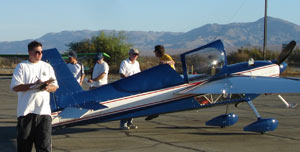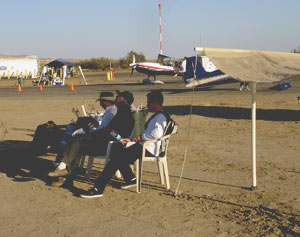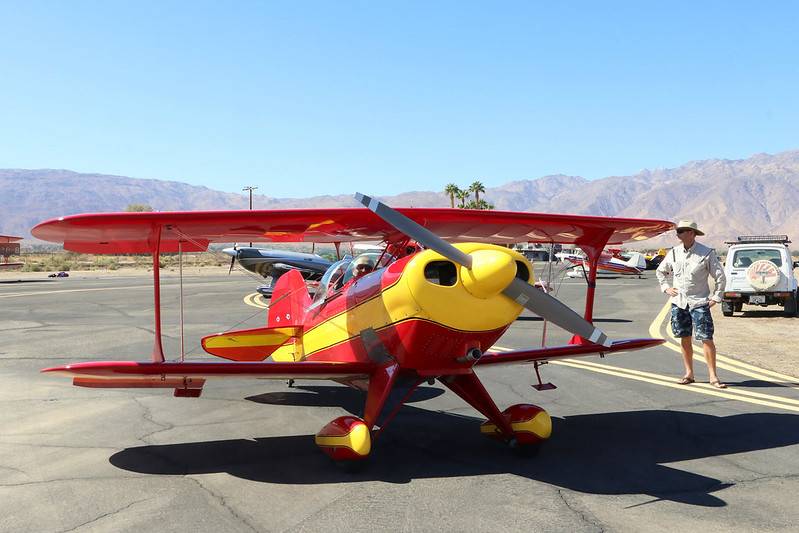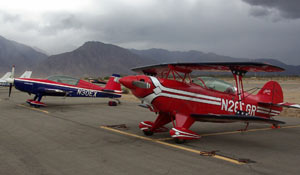So you’re thinking about flying your first contest. Great! Let me share my experience so you’ll know what to expect and how to prepare.
Volunteering
I started by attending several contests not as a competitor, but as a volunteer. That lets you see what a contest is like from a front-row seat!
When you arrive, find the Volunteer Coordinator. Even if you know nothing about competition aerobatics, there’s plenty you can do. You’ll work a variety of positions in one day, so you’ll learn a ton—just bring sunscreen!
Roles
Here’s just a few of the jobs you might find yourself in:
- Recorder
Sit next to the judge grading each competitor and write down the judge’s scores and comments as the flight happens. - Assistant Starter
Help ensure that each competitor is ready to fly when it’s their turn, then launch them! - Chief Judge’s Assistant
Help the Chief Judge run the entire show by verifying scoresheets, talking via radio to the corner judges, and more. - Corner Judge
Sit at the aerobatic box and report when pilots fly out-of-bounds. - Scorer’s Assistant
Help the Scorer enter scores into the IAC Scoring system to tabulate the final rankings.
The other volunteers you work with will often be pilots in the competition, so ask lots of questions! It takes more than 25 people on the ground to run a single flight, so your help literally makes the contest possible.
Getting Ready
After you return—with a t-shirt, new friends, and good memories—it’s time to get ready to compete! Start with an Aerobatic CFI, who will coach you to fly the figures to competition standards. I started with Bill Hill at Sunrise Aviation.
Most people, including me, fly their first competition in the Primary Category. You get to learn the pilot’s side of the contest in a lower-stress environment: there are no boundary penalties to worry about, there are six relatively easy figures in the sequence, and your fellow competitors are also just getting started, so it’s lots of fun.
The Primary Sequence
This sequence is designed to introduce you to the fundamentals of aerobatic flight. It’s easy to learn but hard to master:
- — 45° upline
- — 1.5-turn spin
- — a half-cuban
- — a loop
- — a 180° turn
- — 1 level aileron roll
To score well, you’ll need good training—both in the cockpit and from the ground. Aerobatic competitors are not “stunt pilots” who take great risks; they’re precision aviators who are judged by the toughest critics on the planet: other aerobatic pilots.
Get Coaching

My first coaches were Michael Church and Ty Frisby of Sunrise Aviation and I’m really glad I worked with them before my first contest! There were six pilots in the Primary category I entered. Three of us got coaching beforehand and three didn’t. The three coached pilots finished—you guessed it—first, second, and third.
Join IAC
To compete or practice in the aerobatic box, you must be a member of the International Aerobatic Club. You can join at https://iac.org (This is an FAA requirement because the aerobatic box has special rule-waivers in effect.)
Next, read our contest checklist to make sure you bring all the right paperwork and supplies to your first contest.
Registration Day
This is the first day of the contest. It’s best to arrive early because once you’re checked in you can sign up for a 10-minute practice time in the aerobatic box. By the late afternoon, all the practice slots are usually taken.
When you arrive, find the Registrar. They’ll get your paperwork in order and tell you where to go next. You’ll fill out a short form to sign up for volunteer roles that you’ll fill when you’re not flying. I recommend being a Recorder, because you’ll sit right next to a grading Judge and see how the flights are scored.
Next, the Registrar will send you to the Tech Inspector. This person will examine your paperwork and airplane. Don’t worry—the inspection is just like a normal preflight; no disassembly required! Once this process is complete, you should find the Box Monitor and sign up for a practice time slot.
Practice Flight
Make sure you strap into your plane well before your allotted time slot. You want to be diving into the box at your start time, not still on the ground!

Make sure you have everything for a safe flight: fuel, parachute, tight belts, box frequency, altimeter set to 0′ AGL, and your sequence card. Once you’re out of the traffic pattern, switch to the box frequency and wait to hear the Box Monitor call your name with the magic words: the box is yours!
You don’t have to worry about boundary penalties in Primary, but you should still keep your sequence centered in the box for a higher score. As you fly, note the surrounding terrain so you can build a mental map of where you are in the box.
As you practice, pay close attention to your altitude. For example, how much height do you actually lose during that spin? There is zero tolerance for flying lower than 1,500′ AGL in Primary or Sportsman. The judges will disqualify your entire flight if you do so. In a large airplane such as the Decathlon, give yourself an extra 200-300′ above the minimum because judges may think you’re lower than you really are.
As you finish your practice flight, pay careful attention to how you leave the box and enter the traffic pattern: there may be other planes that are not part of the contest. Go out of your way to accommodate non-aerobatic pilots: it helps us avoid the “hotshot” stereotype.
Contest Flying
The morning of contest flights starts with a mandatory pilot briefing. Don’t be late or you won’t be allowed to fly! During the briefing, you’ll learn the order-of-flight and which volunteer jobs you’ll do. The Contest Director will also explain the procedures for entering and exiting the box, as well as traffic pattern operations—pay close attention!
From now on, no aerobatics are allowed outside of the contest flights. If you fly an aerobatic figure while waiting for your turn in the box, you’ll be removed from the contest completely. You are, however, allowed to check your harness and oil system by briefly rolling inverted and then back upright after the Chief Judge calls you into the box.
Don’t Talk on Box!
During the contest, never talk on the box frequency unless the Chief Judge has called you first—another pilot is flying their sequence and you should not interrupt them. If you have a question (e.g. “why have I been holding for so long?”) switch back to the Starter’s frequency and ask them instead.
Once you’re cleared into the box, just relax and enjoy your flight! You’ll have three flights over the course of the contest, but now is not the time to make major changes. Just keep doing what you’ve practice and fly consistently. You’ll have many hours back home to review the judge’s scoresheets and work with your coach to improve your figures—don’t try to do that in the middle of a contest!
The Awards Banquet
On the last day of the contest, there will be an awards banquet in the evening. Don’t skip it! This is the most fun part of the contest—friends and laughs and great memories.
Pro-Tip: If you want the undying gratitude of the contest staff, help tear down all of the equipment before you leave the airport for the afternoon on the last day.
So that’s it! All you need to know about your first contest: practice, practice, practice, and you’ll earn the right to fly alongside some of the best pilots on Earth.
See you in the box!




